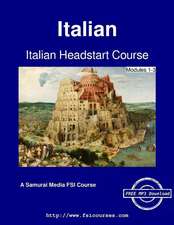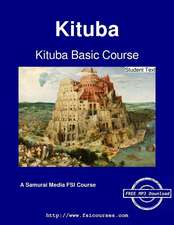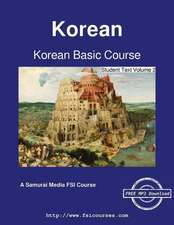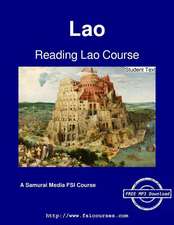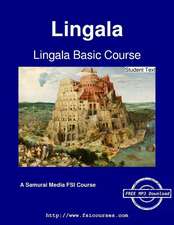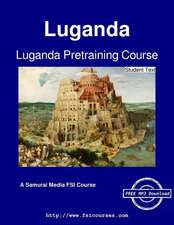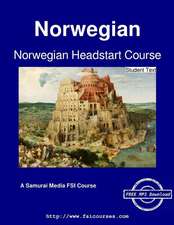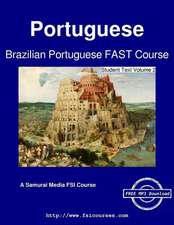Break Through Rapid Reading
Autor Peter Kumpen Limba Engleză Paperback – 31 oct 1998 – vârsta de la 18 ani
Preț: 143.89 lei
Nou
Puncte Express: 216
Preț estimativ în valută:
27.53€ • 28.82$ • 22.78£
27.53€ • 28.82$ • 22.78£
Carte disponibilă
Livrare economică 15-29 martie
Preluare comenzi: 021 569.72.76
Specificații
ISBN-13: 9780735200197
ISBN-10: 073520019X
Pagini: 304
Dimensiuni: 176 x 233 x 20 mm
Greutate: 0.49 kg
Ediția:Revised
Editura: Prentice Hall Press
ISBN-10: 073520019X
Pagini: 304
Dimensiuni: 176 x 233 x 20 mm
Greutate: 0.49 kg
Ediția:Revised
Editura: Prentice Hall Press
Cuprins
Breakthrough Rapid Reading What Breakthrough Rapid Reading Means to You
Chapter One: Save Time by Starting Today
Rapid Reading Is a Skill; Successful Skill Learning; A Senior "Student" Makes It; A Good Reader Is a Flexible Reader; What You Can Expect to Learn; How to Get Started; Exercise No. 1
Chapter Two: Test Your Reading Rate to See Where You Stand
Timing Yourself; Testing Yourself; Computing Your Reading Rate; Evaluating Your Retention; Keeping Your Progress Profile; Evaluating Your Present Skills; Be Sure You're Ready to Begin; A Few Words About Your Eyes
Chapter Three: Start Using Your Built-in Reading Accelerator
What Your Eyes Do When You Read; Regressions Slow Your Rate Considerably; What You Should Know About Reading Conditions; Reading Positions; How to Use Your Hand in Reading; Exercise No. 2; Exercise No. 3
Chapter Four: Eliminate Regressions and Speed Ahead
How People Read Fast; The Next Big Step; Eliminating Regressions; Exercise No. 4; Always Use Your Hand; Getting Ahead
Chapter Five: Build Your Reading Rate through Drilling
The Three Stages of Subvocalizing; Proper Practice Is the Key; How to Learn to Discern Information More Rapidly; Exercise No. 5; Exercise No. 6; Getting Ahead
Practice Drills for Week 2
(Supplementary drills to be done with the next six chapters.)
Chapter Seven: Don't Read Just for Its Own Sake
The First Misconception; The Second Misconception; The Third Misconception; Once Through Is Not Enough; Exercise No. 9; Exercise No. 10; Get Specific with Your Purpose; Know Your Purpose and You Won't Have to Work So Hard; Use These Questions to Start Setting Your Purpose; Set a Purpose for Everything You Read
Chapter Eight: Become One of the World's Faster Readers!
The "Secret" of Speed Reading; A New Drill Can Increase Your Rate Even More; Exercise No. 11; Push Up Even When You're "Reading"; Exercise No. 12; It Can Be Easy to Reach Your Goal
Chapter Nine: Use the Magic Line to Develop Better Reading Recall
The "Acid" Test of Comprehension; The Magic Line; Exercise No. 13; Comprehension Versus Speed; Exercise No. 14; Getting Ahead
Chapter Ten: Stretch Your Rate Higher with a Different Drill
The Range of Efficient Linear Reading; Your Reading Rate Will Vary; The Double/Triple Drill; Exercise No. 15; Reading Versus Practice Reading; Are You Making the Mark?; How to Move Your Hand Faster
Chapter Eleven: Know Writers' Techniques and Help Yourself
The Basic Form of Nonfiction; Exercise No. 16; The Forms of Fiction
Chapter Twelve: Don't Let Turning Pages Slow You Down
"Dusting"; Exercise No. 17; The Glorious Saga of the Windshield Wiper, Solving a Nonreading Problem; Turning Pages the Fast Way; Exercise No. 18; Getting Ahead
Practice Drills for Week 3 (Supplementary drills to be done with the next six chapters)
Chapter Thirteen: Make Difficult Reading Easy
How Abstract the Writing Is Affects Your Understanding; How People Write and Speak; Levels of Generality; The "Testing" Question; Exercise No. 19; Exercise No. 20
Chapter Fourteen: How People Read Really Fast
Evelyn Wood's Remarkable and Simple Discovery; The Differences Between Slow and Fast Readers; How to See Eye Movements; How Much Can the Eyes See?; Why Can't You Understand Lots of Words at a Time; Taking the First Step; Exercise No. 21
Chapter Fifteen: Learn to Read as Fast as You Think
"Reading" at High Rates Feels Different; How to Get Comprehension at Higher Rates; Meaning Isn't Carried by All the Words; You Can Read Out-of-Expectancy Order; Exercise No. 22; Adapt Your Hand Movement to the Paragraph; Exercise No. 23
Chapter Sixteen: How to Start Getting Comprehension at High Speeds
The Three Rules Which Govern Comprehension; Back to the First Grade; Practice As Much As You Can; Exercise No. 24; Exercise No. 25
Chapter Seventeen: Read Without Saying Each Word to Yourself - And Soar
Be Sure You're Ready to Move Ahead; "Paragraphing": The New Hand Movement; Put Your Earplugs On to Practice: The Two Keys to Successful Practice; Exercise No. 26; You're Your Own Best Bet; Exercise No. 27
Chapter Eighteen: How Are You Coming Along?
Re-test Yourself; Are You Ready to Move On?; You Must Evaluate Yourself
Practice Drills for Week 4
(Supplementary drills to be done with the next six chapters.)
Chapter Nineteen: Knowing Reading Signals Helps Speed You Up
Why Signal Words Help You Understand; The Many Kinds of Transition Words; Exercise No. 28; Exercise No. 29; Exercise No. 30; Faster Reading in Harder Materials; High-Speed Practice Helps Lower-Speed Reading
Chapter Twenty: There's More Than One Way to "Read"
Old-Fashioned Speed Reading; Exercise No. 31; Scanning Is Another Reading Alternative; Exercise No. 32; Four Ways of Reading; Leave Your Guilt Behind!
Chapter Twenty-One: Advance Organizers Can Help Your Comrehension
From Whole to Parts; Find the Author's "Map"; Hard Books Are Often the Easiest; Previewing Nonfiction; When There Is No Apparent "Map"; Exercise No. 33
Chapter Twenty-two: Change Your Attitude and Increase Your Speed
What a Basketball Experiment Taught Me; How You're Making Progress When Your Rate Stays the Same - Or Even Drops; Remember the Value of Practice Reading; My "Best" Student; Handle Each Day's Practice by Itself; Exercise No. 34
Chapter Twenty-three: Previewing Fiction Is Always Very Fast
Use Scanning to Preview Fiction; Read for Enjoyment; Beware of Reading Problems; Reviewing: The Third Step; Exercise No. 35
Chapter Twenty-four: A Different Hand Movement Can Help Your Comprehension
The Good Reason for New Hand Movements; The Two Types of Hand Movements; "Underlining" with Two Fingers; The Slashing Hand Movement; The Criss-Crossing Hand Movement; "Criss-Crossing"; Exercise No. 36; And Why Not Straight Down the Page?
Practice Drills for Week 5
(Supplementary drills to be done with the next six chapters.)
Chapter Twenty-five: Make Study Reading a Game
What's Happening While You're Learning; The Mind Can't Handle Everything That Comes to It; Concentration Is a Trick; The Two Rules of Learning; Ways to Increase Your Concentration; The True Test of Learning; Read Aggressively; "Use" the Information Well; Exercise No. 37
Chapter Twenty-six: Read with Defined Purposes
Reading Purposes Vary Widely; When Your Purpose Is Pleasure; A Stock Broker Finds There's More to It Than Speed Alone; Read Smarter and Faster; Don't Let Chance Determine Your Purpose; Levels of Reading and Learning; How to Define a Purpose When Studying; When You're Not Certain; Draw the Recall Pattern in Advance; How to Learn the Correct Information; However You Can Learn Most Efficiently Is the Right Way; Exercise No. 38
Chapter Twenty-seven: "Program" Your Reading to Learn More Efficiently
Spend Less Time to Learn More; The Most Efficient Reading; A Plan for Studying; Don't Read to Remember; Exercise No. 39
Chapter Twenty-eight: Create Visual Patterns to Help Your Recall
The Value of a Recall Pattern Versus an Outline; Taking the Second Step; Recall Patterns Can Vary; Exercise No. 40
Chapter Twenty-nine: Remember More of What You've Read with These Proven Techniques
The Three Steps to Improving Your Retention; Organize Creatively; Associate Information Dramatically; Compare and Contrast; More "Recording" Tricks; Exercise No. 41; Now Apply the Techniques for Yourself; A Final Word
Chapter Thirty: Unravel Difficult Passages This Easy Way
When Reading in a New Field; When the Writing Is Abstract; Success Doesn't Always Mean 100 Percent; How Fast Can You Read?; When Reading Test Materials; Exercise No. 42
Practice Drills for Week 6
(Supplementary drills to be done with the next six chapters.)
Chapter Thirty-one: Develop High Speeds with These Special Drills
It Helps to Be Relaxed; Results Vary with Various Teachers; Is the Glass Half Empty or Half Full?; Exercise No. 43; Exercise No. 44; Practice at Three Times Your Reading Rate
Chapter Thirty-two: Read Your Newspaper Instantaneously
Practice Your New Techniques Where It's Easy; Familiarity Breeds Faster Reading; News Articles Have the Easiest Form of All; A New Way to Read the Newspaper; Narrow Column Hand Movements; Exercise No. 45
Chapter Thirty-three: Don't Waste Your Time Reading the Mail
The First Rule: Handle Everything Only Once; Evaluate a Letter's Importance Right Away; Exercise No. 46
Chapter Thirty-four: Develop the Book-a-Day Habit
First Decide What You Want to Read; How to Get More Books Read; A Book-A-Day Approach; Patrick Buchanan Reads Three Books in Two Flights; The Form of Fiction; A Structural Review of "The Cop and the Anthem"; Exercise No. 47; Names Can Be a Problem; Why Read Novels?
Chapter Thirty-five: Keep Up with Your Magazines and Informational Reading
Use Wisely Whatever Time You Have; Stop Being Compulsive!; When You Find You're Slowing Down; Exercise No. 48; Handle Nonfiction Books the Same Way; Try the Drugstore Drill; Exercise No. 49
Chapter Thirty-six: Find Out Just How Far You've Come
Devise a Six-Month Plan; How Thomas Wolfe Became a Speed Reader; A Few Tips
Practice Drills for Continuing
How to Maintain a Certain Practice Reading Rate
Index
Chapter One: Save Time by Starting Today
Rapid Reading Is a Skill; Successful Skill Learning; A Senior "Student" Makes It; A Good Reader Is a Flexible Reader; What You Can Expect to Learn; How to Get Started; Exercise No. 1
Chapter Two: Test Your Reading Rate to See Where You Stand
Timing Yourself; Testing Yourself; Computing Your Reading Rate; Evaluating Your Retention; Keeping Your Progress Profile; Evaluating Your Present Skills; Be Sure You're Ready to Begin; A Few Words About Your Eyes
Chapter Three: Start Using Your Built-in Reading Accelerator
What Your Eyes Do When You Read; Regressions Slow Your Rate Considerably; What You Should Know About Reading Conditions; Reading Positions; How to Use Your Hand in Reading; Exercise No. 2; Exercise No. 3
Chapter Four: Eliminate Regressions and Speed Ahead
How People Read Fast; The Next Big Step; Eliminating Regressions; Exercise No. 4; Always Use Your Hand; Getting Ahead
Chapter Five: Build Your Reading Rate through Drilling
The Three Stages of Subvocalizing; Proper Practice Is the Key; How to Learn to Discern Information More Rapidly; Exercise No. 5; Exercise No. 6; Getting Ahead
Practice Drills for Week 2
(Supplementary drills to be done with the next six chapters.)
Chapter Seven: Don't Read Just for Its Own Sake
The First Misconception; The Second Misconception; The Third Misconception; Once Through Is Not Enough; Exercise No. 9; Exercise No. 10; Get Specific with Your Purpose; Know Your Purpose and You Won't Have to Work So Hard; Use These Questions to Start Setting Your Purpose; Set a Purpose for Everything You Read
Chapter Eight: Become One of the World's Faster Readers!
The "Secret" of Speed Reading; A New Drill Can Increase Your Rate Even More; Exercise No. 11; Push Up Even When You're "Reading"; Exercise No. 12; It Can Be Easy to Reach Your Goal
Chapter Nine: Use the Magic Line to Develop Better Reading Recall
The "Acid" Test of Comprehension; The Magic Line; Exercise No. 13; Comprehension Versus Speed; Exercise No. 14; Getting Ahead
Chapter Ten: Stretch Your Rate Higher with a Different Drill
The Range of Efficient Linear Reading; Your Reading Rate Will Vary; The Double/Triple Drill; Exercise No. 15; Reading Versus Practice Reading; Are You Making the Mark?; How to Move Your Hand Faster
Chapter Eleven: Know Writers' Techniques and Help Yourself
The Basic Form of Nonfiction; Exercise No. 16; The Forms of Fiction
Chapter Twelve: Don't Let Turning Pages Slow You Down
"Dusting"; Exercise No. 17; The Glorious Saga of the Windshield Wiper, Solving a Nonreading Problem; Turning Pages the Fast Way; Exercise No. 18; Getting Ahead
Practice Drills for Week 3 (Supplementary drills to be done with the next six chapters)
Chapter Thirteen: Make Difficult Reading Easy
How Abstract the Writing Is Affects Your Understanding; How People Write and Speak; Levels of Generality; The "Testing" Question; Exercise No. 19; Exercise No. 20
Chapter Fourteen: How People Read Really Fast
Evelyn Wood's Remarkable and Simple Discovery; The Differences Between Slow and Fast Readers; How to See Eye Movements; How Much Can the Eyes See?; Why Can't You Understand Lots of Words at a Time; Taking the First Step; Exercise No. 21
Chapter Fifteen: Learn to Read as Fast as You Think
"Reading" at High Rates Feels Different; How to Get Comprehension at Higher Rates; Meaning Isn't Carried by All the Words; You Can Read Out-of-Expectancy Order; Exercise No. 22; Adapt Your Hand Movement to the Paragraph; Exercise No. 23
Chapter Sixteen: How to Start Getting Comprehension at High Speeds
The Three Rules Which Govern Comprehension; Back to the First Grade; Practice As Much As You Can; Exercise No. 24; Exercise No. 25
Chapter Seventeen: Read Without Saying Each Word to Yourself - And Soar
Be Sure You're Ready to Move Ahead; "Paragraphing": The New Hand Movement; Put Your Earplugs On to Practice: The Two Keys to Successful Practice; Exercise No. 26; You're Your Own Best Bet; Exercise No. 27
Chapter Eighteen: How Are You Coming Along?
Re-test Yourself; Are You Ready to Move On?; You Must Evaluate Yourself
Practice Drills for Week 4
(Supplementary drills to be done with the next six chapters.)
Chapter Nineteen: Knowing Reading Signals Helps Speed You Up
Why Signal Words Help You Understand; The Many Kinds of Transition Words; Exercise No. 28; Exercise No. 29; Exercise No. 30; Faster Reading in Harder Materials; High-Speed Practice Helps Lower-Speed Reading
Chapter Twenty: There's More Than One Way to "Read"
Old-Fashioned Speed Reading; Exercise No. 31; Scanning Is Another Reading Alternative; Exercise No. 32; Four Ways of Reading; Leave Your Guilt Behind!
Chapter Twenty-One: Advance Organizers Can Help Your Comrehension
From Whole to Parts; Find the Author's "Map"; Hard Books Are Often the Easiest; Previewing Nonfiction; When There Is No Apparent "Map"; Exercise No. 33
Chapter Twenty-two: Change Your Attitude and Increase Your Speed
What a Basketball Experiment Taught Me; How You're Making Progress When Your Rate Stays the Same - Or Even Drops; Remember the Value of Practice Reading; My "Best" Student; Handle Each Day's Practice by Itself; Exercise No. 34
Chapter Twenty-three: Previewing Fiction Is Always Very Fast
Use Scanning to Preview Fiction; Read for Enjoyment; Beware of Reading Problems; Reviewing: The Third Step; Exercise No. 35
Chapter Twenty-four: A Different Hand Movement Can Help Your Comprehension
The Good Reason for New Hand Movements; The Two Types of Hand Movements; "Underlining" with Two Fingers; The Slashing Hand Movement; The Criss-Crossing Hand Movement; "Criss-Crossing"; Exercise No. 36; And Why Not Straight Down the Page?
Practice Drills for Week 5
(Supplementary drills to be done with the next six chapters.)
Chapter Twenty-five: Make Study Reading a Game
What's Happening While You're Learning; The Mind Can't Handle Everything That Comes to It; Concentration Is a Trick; The Two Rules of Learning; Ways to Increase Your Concentration; The True Test of Learning; Read Aggressively; "Use" the Information Well; Exercise No. 37
Chapter Twenty-six: Read with Defined Purposes
Reading Purposes Vary Widely; When Your Purpose Is Pleasure; A Stock Broker Finds There's More to It Than Speed Alone; Read Smarter and Faster; Don't Let Chance Determine Your Purpose; Levels of Reading and Learning; How to Define a Purpose When Studying; When You're Not Certain; Draw the Recall Pattern in Advance; How to Learn the Correct Information; However You Can Learn Most Efficiently Is the Right Way; Exercise No. 38
Chapter Twenty-seven: "Program" Your Reading to Learn More Efficiently
Spend Less Time to Learn More; The Most Efficient Reading; A Plan for Studying; Don't Read to Remember; Exercise No. 39
Chapter Twenty-eight: Create Visual Patterns to Help Your Recall
The Value of a Recall Pattern Versus an Outline; Taking the Second Step; Recall Patterns Can Vary; Exercise No. 40
Chapter Twenty-nine: Remember More of What You've Read with These Proven Techniques
The Three Steps to Improving Your Retention; Organize Creatively; Associate Information Dramatically; Compare and Contrast; More "Recording" Tricks; Exercise No. 41; Now Apply the Techniques for Yourself; A Final Word
Chapter Thirty: Unravel Difficult Passages This Easy Way
When Reading in a New Field; When the Writing Is Abstract; Success Doesn't Always Mean 100 Percent; How Fast Can You Read?; When Reading Test Materials; Exercise No. 42
Practice Drills for Week 6
(Supplementary drills to be done with the next six chapters.)
Chapter Thirty-one: Develop High Speeds with These Special Drills
It Helps to Be Relaxed; Results Vary with Various Teachers; Is the Glass Half Empty or Half Full?; Exercise No. 43; Exercise No. 44; Practice at Three Times Your Reading Rate
Chapter Thirty-two: Read Your Newspaper Instantaneously
Practice Your New Techniques Where It's Easy; Familiarity Breeds Faster Reading; News Articles Have the Easiest Form of All; A New Way to Read the Newspaper; Narrow Column Hand Movements; Exercise No. 45
Chapter Thirty-three: Don't Waste Your Time Reading the Mail
The First Rule: Handle Everything Only Once; Evaluate a Letter's Importance Right Away; Exercise No. 46
Chapter Thirty-four: Develop the Book-a-Day Habit
First Decide What You Want to Read; How to Get More Books Read; A Book-A-Day Approach; Patrick Buchanan Reads Three Books in Two Flights; The Form of Fiction; A Structural Review of "The Cop and the Anthem"; Exercise No. 47; Names Can Be a Problem; Why Read Novels?
Chapter Thirty-five: Keep Up with Your Magazines and Informational Reading
Use Wisely Whatever Time You Have; Stop Being Compulsive!; When You Find You're Slowing Down; Exercise No. 48; Handle Nonfiction Books the Same Way; Try the Drugstore Drill; Exercise No. 49
Chapter Thirty-six: Find Out Just How Far You've Come
Devise a Six-Month Plan; How Thomas Wolfe Became a Speed Reader; A Few Tips
Practice Drills for Continuing
How to Maintain a Certain Practice Reading Rate
Index


